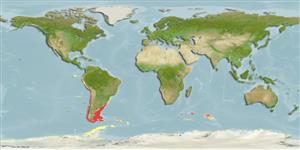Common names from other countries
Environment: milieu / climate zone / depth range / distribution range
Ecología
; rango de profundidad 0 - 315 m (Ref. 87801). Temperate
Distribución
Países | Áreas FAO | Ecosistemas | Ocurrencias, apariciones | Introducciones
Southern Ocean.
Length at first maturity / Tamaño / Peso / Age
Maturity: Lm ? range ? - ? cm
It is found on rocky substrates at depths of 0 to 315 m (Ref. 87801).
Life cycle and mating behavior
Madurez | Reproducción | Puesta | Huevos | Fecundidad | Larva
Members of the class Echinoidea are gonochoric. Fertilization is external. Brooding is common, eggs are held either on the peristome, around the periproct or deep into the concavities on the petaloids. Life cycle: Embryos develop into planktotrophic larvae (echinoplateus) and live for several months before they sink to the bottom using their tube feet to adhere on the ground where they metamorphose into young urchins.
Häussermann, V. and G. Försterra. 2009. (Ref. 87801)
IUCN Red List Status (Ref. 130435)
Warning: mysqli::__construct(): (08004/1040): Too many connections in C:\Apache24\htdocs\includes\func_getlabel.php on line 46
Can't connect to MySQL database (slbapp). Errorcode: Too many connections
